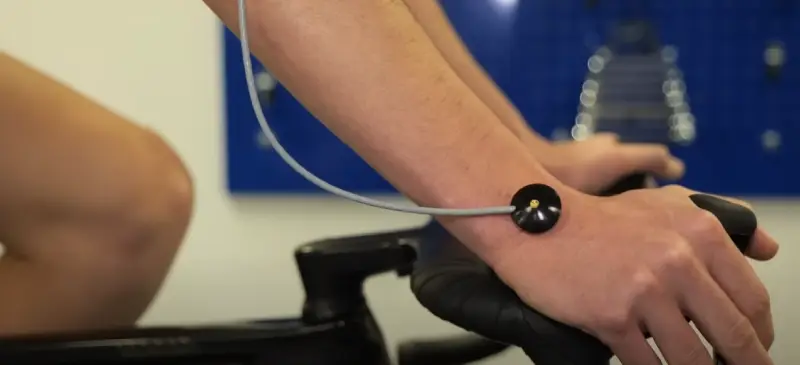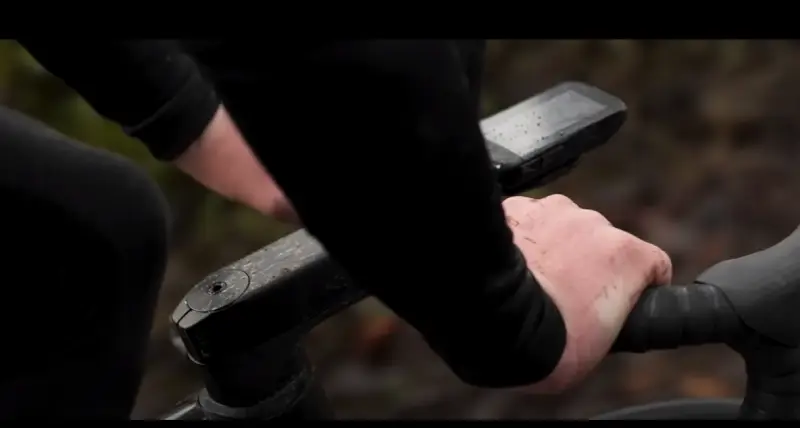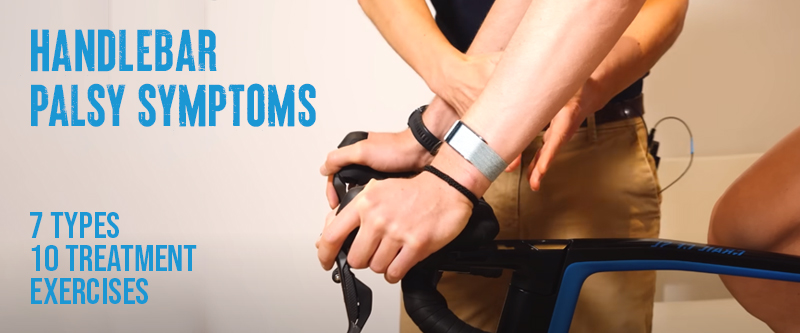Handlebar Palsy is a condition that affects cyclists, causing tingling or numbness in the hands and potentially leading to a loss of control and accidents. It can also affect grip strength for everyday tasks.
Prompt treatment is essential to prevent worsening symptoms and permanent nerve damage. Cyclists who ride on bumpy terrain or wear worn-out handlebar grips are also at higher risk, so being mindful and taking breaks is crucial.
Handlebar palsy, also known as cyclist’s palsy, can present with symptoms such as numbness, tingling, or a burning sensation in the little finger side of the hand, ring, and pinkie. Other symptoms can include muscle or hand cramps, loss of or weakness of specific hand movements, and clumsiness.
In this blog post, we will explore handlebar palsy symptoms, causes, treatment, and exercises for recovery.
Handlebar Palsy Symptoms: 7 Main Warning Signs

If you’re an avid cyclist, you may have experienced the symptoms of handlebar palsy at one point or another. Handlebar palsy, also known as ulnar neuropathy or cyclist’s palsy, is a nerve disorder that affects the hands and wrists, and it can be pretty debilitating. Here are some signs and symptoms of handlebar palsy.
Tingling and Numbness in the Hands
One of the most common symptoms of handlebar palsy is the numbness or tingling in the hands. Pins and needles are often described as this sensation. The affected area typically includes the ring and pinky fingers, as well as the outside of the hand.
Weakness in the Forearms and Wrists
Another sign of handlebar palsy is the weakness of the forearms and wrists. This weakness can affect one or both arms and make it difficult to grip or lift objects. It may also lead to muscle fatigue and cramping.
Pain and Discomfort in the Hands and Wrists
Handlebar palsy sometimes causes tingling and weakness besides discomfort and pain in the hands and wrists. It is possible to experience sharp or dull pain during the day and physical activity.
Loss of Grip Strength
People with handlebar palsy may also have a loss of grip strength. This can make it difficult to hold on to objects such as handlebars, doorknobs, or cutlery. It may make it difficult to carry out everyday tasks in severe cases.
Hand Weakness and Cramps
Another common symptom of handlebar palsy is hand weakness and cramps. It can make it hard to perform delicate motor tasks, like typing or playing a musical instrument.
Decreased Movement of Ring and Pink Singers
A further sign of handlebar palsy is decreased ring movement and pinky fingers. This may make it difficult to perform tasks like buttoning a shirt or using a computer mouse.
Inability To Tuck Your Pinky Close To Your Ring Finger
Those with handlebar palsy may also experience an inability to tuck their pinky finger close to their ring finger. This is because muscle weakness controls this movement and limits the ability to carry out daily activities.
7 Causes of Handlebar Palsy
Handlebar palsy is commonly observed in cyclists, particularly those who ride their bikes with their hands on the handlebars. It is characterized by numbness, tingling, or weakness in the hand and arm and can be caused by various factors. Here are some causes:
- Poor Handlebar Positioning: The position of the handlebars plays a vital role in preventing Handlebar Palsy. If the handlebars are too low, the pressure on your hands will increase, leading to numbness and pain. Similarly, if the handlebars are too high, it will cause a poor grip position, causing numbness and weakness.
- Prolonged Cycling without Breaks: Cycling for long durations without taking a break can cause Handlebar Palsy, as it continuously pressures your hands and wrists.
- Holding onto the Handlebars too Tightly: Cycling with a tight grip on the handlebars can also cause Handlebar Palsy, as it compresses the nerves running through your hands.
- Prolonged Extreme Wrist Position: Keeping your hands in an unnatural position for long periods can lead to Handlebar Palsy. For example, if your wrists are flexed or extended, it can cause numbness and tingling in your fingers.
- Poor Posture and Weak Core: Poor cycling posture can cause pressure on your hands, increasing the risk of Handlebar Palsy. Similarly, having weak core muscles can cause poor support for your upper body, leading to nerve compression in your hands.
- High Vibration: Riding a bike with over-inflated or skinny tires, small wheels, or rough terrain can increase the level of vibration in your bicycle, causing handlebar palsy.
- High Bike Saddle: A high bike saddle can cause an awkward angle for your wrists and lead to compression of the nerves in your hands.
How To Treat Handlebar Palsy Symptoms: 10 Ways

Cyclist’s palsy can occur because of frequent cycling or other activities involving prolonged palm and wrist pressure. The symptoms of handlebar palsy can be discomfort, but various treatments are available to ease pain and discomfort.
- Rest and Don’t Do Things that Exacerbate Symptoms: One of the first steps to treat handlebar palsy is to rest the affected area and avoid activities that aggravate symptoms. While it may be difficult to prevent all actions, it’s essential to understand that rest is critical for the healing process.
- Use of Wrist Splints or Braces: Wrist splints or braces can help support the wrist, prevent further nerve damage, and reduce pain and discomfort. Use wrist splints or braces your doctor or physical therapist recommends.
- Anti-inflammatory Medication: Non-steroidal anti-inflammatory medications, like ibuprofen, relieve inflammation and pain associated with handlebar palsy. Be sure to consult your doctor before taking any medication.
- Corticosteroid Injections: In some cases, corticosteroid injections can help ease handlebar palsy symptoms. A needle injection reduces inflammation and swelling in the affected area. Be sure to talk to your doctor about the risks and benefits of corticosteroid injections.
- Looking beyond your hands: Cycling is physically demanding, and riders can experience stress from awkward postures, weather, vibration, and falls. Poor cycling posture can compress nerves and cause symptoms in the arms.
- Using padded gloves and handlebars: Padded cycling gloves and handlebars help disperse the force throughout your hands and decrease pressure on your wrists.
- General strengthening: Incorporate strengthening exercises into your training routine to reduce wrist strain. A strong core, back, and upper arms improve stability and distribute weight between the saddle and handlebars. Assess strengths and weaknesses to create a personalized strength program for optimal cycling performance.
- Changing hand positions: For hand position while cycling, there isn’t a perfect stance that applies to everyone. The key is to switch up your hand position frequently to prevent excessive strain on any area. Doing so can ensure a more comfortable and balanced riding experience, reducing the risk of discomfort or injury.
- Moving your saddle: If you want to change to help decrease the pressure on your wrists, you can lower your saddle and move it backward. There will be a posterior shift in weight distribution, with your saddle supporting a more significant portion of your load than your handlebars.
- Get a professional bike fit: We aren’t experts in bike fit. Many equipment options and subtle variations in fitting a bike to a cyclist’s requirements exist. Suppose you engage in a significant amount of cycling. In that case, we highly recommend getting a professional bike fit to prevent injury.
4 Exercises To Treat Handlebar Palsy Symptoms
Handlebar palsy happens when the ulnar nerve is compressed in the wrist. It can cause weakness in the hand and forearm, particularly in avid cyclists. Several handlebar palsy treatment exercises can help those who suffer from this condition. Below are a few practical handlebar palsy treatment exercises that individuals can try:
- Wrist Flexor and Extensor Stretches: One of the most effective exercises involves stretching the wrist and extensor muscles. This comprises extending the arm and bending the wrist downward and upward for 10 seconds. This exercise should be repeated several times.
- Grip Strengthening Exercises: Grip strengthening exercises can also help relieve handlebar palsy symptoms. Squeezing a hand grip for up to 30 seconds can help support the grip and reduce the chance of compression on the ulnar nerve.
- Forearm Pronation and Supination Exercises: Forearm pronation and supination exercises involve rotating the forearm while holding a lightweight. Strong muscles help relieve Ulnar’s nerve pressure. Repetition of this exercise is recommended, accumulating the weight as strength improves.
- Finger Mobility Exercises: Finger mobility exercises can also help relieve the symptoms of handlebar palsy. They involve moving the fingers up and down while holding a weight or using a grip strength trainer. This exercise can help improve mobility and reduce pressure on the ulnar nerve.
Handlebar Palsy Recovery Time & Factors Affecting Recovery

A more severe case of handlebar palsy can take weeks or months to heal. While the nerve and muscles regenerate, the patient must interrupt his sports activities. For severe cases of handlebar palsy, the healing process can take several weeks to months, based on the severity of the condition. During this time, as the nerves and muscles regenerate, it is recommended that patients discontinue any sports activities for a period.
- Severity of the Condition: Mild cases of handlebar palsy may resolve independently within a few days, but more severe cases may take months.
- Treatment: There are several treatment options available for handlebar palsy, including rest, ice, stretching, physical therapy, and anti-inflammatory medications. Get treatment sooner, and your recovery time may be.
- Anatomy: The anatomy of your hand and wrist can affect your recovery time. Handlebar palsy may be more prevalent in people with smaller hands or a shorter ulnar nerve.
- Riding Habits: Constant pressure on the ulnar nerve can exacerbate handlebar palsy symptoms. Adjusting your riding position, using gel-padded gloves, and taking breaks can reduce re-injury risk.
Conclusion
People with handlebar palsy are often cyclists and motorcycle enthusiasts. This condition can have mild to severe symptoms and, if not treated, can be debilitating. The most common symptoms are typically numbness, tingling, and hand weakness.
Taking good care of your hands is crucial, and finding joy in cycling and motorcycling is equally essential. Properly adjusting your bike or motorcycle handlebars and using proper gloves can go a long way in preventing Handlebar Palsy. Seeking medical attention is also necessary to prevent the condition from getting worse. With the treatment and recovery, you can manage this condition effectively and enjoy your rides without pain or discomfort.
FAQs
When Should I Seek Medical Attention For Handlebar Palsy Symptoms?
If handlebar palsy symptoms persist or worsen, it’s best to consult a healthcare professional to manage discomfort or potential nerve damage.
How Is Handlebar Palsy Diagnosed?
Diagnosis of handlebar palsy is typically based on physical examination and a thorough medical history. Doctors may also use diagnostic tests such as electromyography (EMG) and nerve conduction tests to assess nerve function and rule out other reasons for the symptoms.


